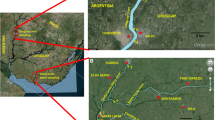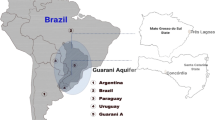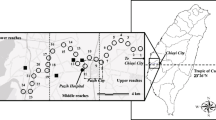Abstract
The Negro River is located in the Amazon basin, the largest hydrological catchment in the world. Its water is used for drinking, domestic activities, recreation and transportation and water quality is significantly affected by anthropogenic impacts. The goals of this study were to determine the presence and concentrations of the main viral etiological agents of acute gastroenteritis, such as group A rotavirus (RVA) and genogroup II norovirus (NoV GII), and to assess the use of human adenovirus (HAdV) and JC polyomavirus (JCPyV) as viral indicators of human faecal contamination in the aquatic environment of Manaus under different hydrological scenarios. Water samples were collected along Negro River and in small streams known as igarapés. Viruses were concentrated by an organic flocculation method and detected by quantitative PCR. From 272 samples analysed, HAdV was detected in 91.9 %, followed by JCPyV (69.5 %), RVA (23.9 %) and NoV GII (7.4 %). Viral concentrations ranged from 102 to 106 GC L−1 and viruses were more likely to be detected during the flood season, with the exception of NoV GII, which was detected only during the dry season. Statistically significant differences on virus concentrations between dry and flood seasons were observed only for RVA. The HAdV data provides a useful complement to faecal indicator bacteria in the monitoring of aquatic environments. Overall results demonstrated that the hydrological cycle of the Negro River in the Amazon Basin affects the dynamics of viruses in aquatic environments and, consequently, the exposure of citizens to these waterborne pathogens.






Similar content being viewed by others

References
Ahmed, S. M., Hall, A. J., Robinson, A. E., Verhoef, L., Premkumar, P., Parashar, U. D., et al. (2014). Global prevalence of norovirus in cases of gastroenteritis: a systematic review and meta-analysis. The Lancet Infectious Diseases, 14(8), 725–730.
Albinana-Gimenez, N., Miagostovich, M. P., Calgua, B., Huguet, J. M., Matia, L., & Girones, R. (2009). Analysis of adenoviruses and polyomaviruses quantified by qPCR as indicators of water quality in source and drinking-water treatment plants. Water Research, 43(7), 2011–2019.
Aw, T. G., & Gin, K. Y. (2011). Prevalence and genetic diversity of waterborne pathogenic viruses in surface in surface waters of tropical urban catchments. Journal of Applied Microbiology, 110(4), 903–914.
Barril, P. A., Fumian, T. M., Prez, V. E., Gil, P. I., Martínez, L. C., Giordano, M. O., et al. (2015). Rotavirus seasonality in urban sewage from Argentina: effect of meteorological variables on the viral load and the genetic diversity. Environmental Research, 138, 409–415.
Barril, P. A., Giordano, M. O., Isa, M. B., Masachessi, G., Ferreyra, L. J., Castello, A. A., et al. (2010). Correlation between rotavirus A genotypes detected in hospitalized children and sewage samples in 2006, Córdoba, Argentina. Journal of Medical Virology, 82(7), 1277–1281.
Bofill-Mas, S., Albinana-Gimenez, N., Clemente-Casares, P., Hundesa, A., Rodriguez-Manzano, J., Allard, A., et al. (2006). Quantification and stability of human adenoviruses and polyomavirus JCPyV in wastewater matrices. Applied and Environmental Microbiology, 72(12), 7894–7896.
Bofill-Mas, S., & Girones, R. (2003). Role of the environment in the transmission of JC virus. Journal of NeuroVirology, 9(Suppl 1), 54–58.
Bofill-Mas, S., Rusiñol, M., Fernandez-Cassi, X., Carratalà, A., Hundesa, A., & Girones, R. (2013). Quantification of human and animal viruses to differentiate the origin of the fecal contamination present in environmental samples. BioMed Research International, 2013, 192089.
Braeye, T., De Schrijver, K., Wollants, E., van Ranst, M., & Verhaegen, J. (2015). A large community outbreak of gastroenteritis associated with consumption of drinking water contaminated by river water, Belgium, 2010. Epidemiology & Infection, 143(4), 711–719.
Calgua, B., Barardi, C. R., Bofill-Mas, S., Rodriguez-Manzano, J., & Girones, R. (2011). Detection and quantification of infectious human adenoviruses and JC polyomaviruses in water by immunofluorescence assay. Journal of Virological Methods, 171(1), 1–7.
Calgua, B., Fumian, T., Rusiñol, M., Rodriguez-Manzano, J., Mbayed, V. A., Bofill-Mas, S., et al. (2013a). Detection and quantification of classic and emerging viruses by skimmed-milk flocculation and PCR in river water from two geographical areas. Water Research, 47(8), 2797–2810.
Calgua, B., Mengewein, A., Grunert, A., Bofill-Mas, S., Clemente-Casares, P., Hundesa, A., et al. (2008). Development and application of a one-step low cost procedure to concentrate viruses from seawater samples. Journal of Virological Methods, 153(2), 79–83.
Calgua, B., Rodriguez-Manzano, J., Hundesa, A., Suñen, E., Calvo, M., Bofill-Mas, S., et al. (2013b). New methods for the concentration of viruses from urban sewage using quantitative PCR. Journal of Virological Methods, 187(2), 215–221.
Carvalho-Costa, F. A., Volotão, Ede M., de Assis, R. M., Fialho, A. M., de Andrade, Jda S., Rocha, L. N., et al. (2011). Laboratory-based rotavirus surveillance during the introduction of a vaccination program, Brazil, 2005–2009. Pediatric Infectious Disease Journal, 30(1 Suppl), S35–S41.
CONAMA—National Environment Council (Conselho Nacional do Meio Ambiente). (2000). Ministério do Meio Ambiente. Resolução 274 de 29 de novembro de 2000. Diário Oficial da República Federativa do Brasil, Poder Executivo, Brasília, DF.
da Silva Soares, L., de Fátima Dos Santos Guerra, S., do Socorro Lima de Oliveira, A., da Silva Dos Santos, F., de Fátima Costa de Menezes, E. M., Mascarenhas, J. D., et al. (2014). Diversity of rotavirus strains circulating in Northern Brazil after introduction of a rotavirus vaccine: high prevalence of G3P[6] genotype. Journal of Medical Virology, 86(6), 1065–1072.
Di Bartolo, I., Pavoni, E., Tofani, S., Consoli, M., Galuppini, E., Losio, M. N., et al. (2015). Waterborne norovirus outbreak during a summer excursion in Northern Italy. New Microbiologica, 38(1), 109–112.
Fioretti, J. M., Bello, G., Rocha, M. S., Victoria, M., Leite, J. P., & Miagostovich, M. P. (2014). Temporal dynamics of norovirus GII.4 variants in Brazil between 2004 and 2012. PLoS One, 9(3), e92988.
Fioretti, J. M., Ferreira, M. S., Victoria, M., Vieira, C. B., Xavier, Mda P., Leite, J. P., et al. (2011). Genetic diversity of noroviruses in Brazil. Memórias do Instituto Oswaldo Cruz, 106(8), 942–947.
Flannery, J., Keaveney, S., Rajko-Nenow, P., O’Flaherty, V., & Doré, W. (2012). Concentration of norovirus during wastewater treatment and its impact on oyster contamination. Applied and Environmental Microbiology, 78(9), 3400–3406.
Fong, T. T., & Lipp, E. K. (2005). Enteric viruses of humans and animals in aquatic environments: Health risks, detection, and potential water quality assessment tools. Microbiology and Molecular Biology Reviews, 69(2), 357–371.
Fong, T. T., Phanikumar, M. S., Xagoraraki, I., & Rose, J. B. (2010). Quantitative detection of human adenoviruses in wastewater and combined sewer overflows influencing a Michigan river. Applied and Environmental Microbiology, 76(3), 715–723.
Frappart, F., Seyler, F., Martinez, J.-M., Leon, J. G., & Cazenave, A. (2005). Floodplain water storage in the Negro River basin estimated from microwave remote sensing of inundation area and water levels. Remote Sensing of Environment, 99(4), 387–399.
Fumian, T. M., Leite, J. P., Rose, T. L., Prado, T., & Miagostovich, M. P. (2011). One year environmental surveillance of rotavirus specie A (RVA) genotypes in circulation after the introduction of the Rotarix® vaccine in Rio de Janeiro, Brazil. Water Research, 45(17), 5755–5763.
Fumian, T. M., Vieira, C. B., Leite, J. P., & Miagostovich, M. P. (2013). Assessment of burden of virus agents in an urban sewage treatment plant in Rio de Janeiro, Brazil. Journal of Water and Health, 11(1), 110–119.
Hernroth, B. E., Conden-Hansson, A. C., Rehnstam-Holm, A. S., Girones, R., & Allard, A. K. (2002). Environmental factors influencing human viral pathogens and their potential indicator organisms in the blue mussel, Mytilus edulis: The first Scandinavian report. Applied and Environmental Microbiology, 68(9), 4523–4533.
Hewitt, J., Greening, G. E., Leonard, M., & Lewis, G. D. (2013). Evaluation of human adenovirus and human polyomavirus as indicators of human sewage contamination in the aquatic environment. Water Research, 47(17), 6750–6761.
IBGE—The Brazilian Institute of Geography and Statistics (Instituto Brasileiro de Geografia e Estatística). (2015). Retrieved May 10, 2015 from http://cidades.ibge.gov.br/xtras/perfil.php?codmun=130260.
Jain, S., Vashistt, J., & Changotra, H. (2014). Rotaviruses: Is their surveillance needed? Vaccine, 32(27), 3367–3378.
Kageyama, T., Kojima, S., Shinohara, M., Uchida, K., Fukushi, S., Hoshino, F. B., et al. (2003). Broadly reactive and highly sensitive assay for Norwalk-like viruses based on real-time quantitative reverse transcription-PCR. Journal of Clinical Microbiology, 41(4), 1548–1557.
Leite, J. P., Carvalho-Costa, F. A., & Linhares, A. C. (2008). Group A rotavirus genotypes and the ongoing Brazilian experience: A review. Memórias do Instituto Oswaldo Cruz, 103(8), 745–753.
Levy, K., Hubbard, A. E., & Eisenberg, J. N. (2009). Seasonality of rotavirus disease in the tropics: A systematic review and meta-analysis. International Journal of Epidemiology, 38(6), 1487–1496.
Li, D., Gu, A. Z., Zeng, S. Y., Yang, W., He, M., & Shi, H. C. (2011). Monitoring and evaluation of infectious rotaviruses in various wastewater effluents and receiving waters revealed correlation and seasonal pattern of occurrences. Journal of Applied Microbiology, 110(5), 1129–1137.
Linhares, A. C., & Justino, M. C. (2014). Rotavirus vaccination in Brazil: Effectiveness and health impact seven years post-introduction. Expert Review of Vaccines, 13(1), 43–57.
Loisy, F., Atmar, R. L., Guillon, P., Le Cann, P., Pommepuy, M., & Le Guyader, F. S. (2005). Real-time RT-PCR for norovirus screening in shellfish. Journal of Virological Methods, 123(1), 1–7.
Magalhães, F., & Rojas, E. (2005). The re-urbanization of the city center of Manaus, Brazil—Facing the challenges of informal settlements. 41st ISoCaRP Congress. Bilbao.
Marion, J. W., Lee, C., Lee, C. S., Wang, Q., Lemeshow, S., Buckley, T. J., et al. (2014). Integrating bacterial and viral water quality assessment to predict swimming-associated illness at a freshwater beach: A cohort study. PLoS One, 9(11), e112029.
MDDA—Brazilian Program of Monitoring Acute Diarrheal Diseases (Programa Brasileiro de Monitorização das Doenças Diarreicas Agudas). (2015). Ministério da Saúde, Brasília, DF.
Mellou, K., Katsioulis, A., Potamiti-Komi, M., Pournaras, S., Kyritsi, M., Katsiaflaka, A., et al. (2014). A large waterborne gastroenteritis outbreak in central Greece, March 2012: Challenges for the investigation and management. Epidemiology and Infection, 142(1), 40–50.
Melo, G. Z. S., Costa, C. A., & Santos, I. G. C. (2013). Diversidade molecular de rotavírus do grupo A na cidade de Manaus, Estado do Amazonas, Brasil, 2004 a 2006. Epidemiologia e Serviços de Saúde, 22(2), 265–272.
Miagostovich, M. P., Ferreira, F. F., Guimarães, F. R., Fumian, T. M., Diniz-Mendes, L., Luz, S. L., et al. (2008). Molecular detection and characterization of gastroenteritis viruses occurring naturally in the stream waters of Manaus, central Amazonia, Brazil. Applied and Environmental Microbiology, 74(2), 375–382.
Myrmel, M., Lange, H., & Rimstad, E. (2015). A 1-year quantitative survey of Noro-, Adeno-, Human Boca-, and Hepatitis E viruses in raw and secondarily treated sewage from two plants in Norway. Food and Environmental Virology, 7(3), 213–223.
Norman, G., Pedley, S., & Takkouche, B. (2010). Effects of sewerage on diarrhoea and enteric infections: A systematic review and meta-analysis. The Lancet Infectious Diseases, 10(8), 536–544.
Pal, A., Sirota, L., Maudru, T., Peden, K., & Lewis, A. M. (2006). Real-time, quantitative PCR assays for the detection of virus-specific DNA in simples with mixed populations of polyomaviruses. Journal of Virological Methods, 135(1), 32–42.
PATH—Program for Appropriate Technology in Health. (2015). Retrieved July 10, 2015 from http://sites.path.org/rotavirusvaccine/files/2015/04/PATH-Worldwide-Rotavirus-Vaccine-Introduction-Map-geo-2015.04.01.jpg.
Pina, S., Puig, M., Lucena, F., Jofre, J., & Girones, R. (1998). Viral pollution in the environment and in shellfish: Human adenovirus detection by PCR as an index of human viruses. Applied and Environmental Microbiology, 64(9), 3376–3382.
Port of Manaus (Porto de Manaus). (2015). Retrieved May 10, 2015 from http://www.portodemanaus.com.br/?pagina=niveis-maximo-minimo-do-rio-negro.
Prevost, B., Lucas, F. S., Goncalves, A., Richard, F., Moulin, L., & Wurtzer, S. (2015). Large scale survey of enteric viruses in river and waste water underlines the health status of the local population. Environment International, 79, 42–50.
PROSAMIM—Social and Environmental Program for the Igarapés in Manaus (Programa Ambiental e Social dos Igarapés de Manaus). PROGRAMA AMBIENTAL E SOCIAL DOS IGARAPÉS DE MANAUS (PROSAMIM III). Relatório de Gestão Ambiental e Social—RGAS. (2011). Luis Fernando Galli.
PROSAMIM—Social and Environmental Program for the Igarapés in Manaus (Programa Social e Ambiental dos Igarapés de Manaus). PROSAMIM III—Igarapé São Raimundo Projeto Executivo. Igarapé São Raimundo, RIMA—Relatório de Impacto Ambiental—REV. 01. (2012). Governo do Estado do Amazonas, Secretaria de Estado de Infra-estrutura, Unidade de Gerenciamento de Programa Social e Ambiental dos Igarapés de Manaus (UGPI) e Concremat Engenharia.
PROSAMIM—Social and Environmental Program for the Igarapés in Manaus (Programa Social e Ambiental dos Igarapés de Manaus). Relatório de Impacto Ambiental—RIMA. Manaus, Igarapé do Educandos. (2004). Governo do Estado do Amazonas, Secretaria de Estado de Infra-estrutura e Concremat Engenharia.
Rodríguez-Díaz, J., Querales, L., Caraballo, L., Vizzi, E., Liprandi, F., Takiff, H., et al. (2009). Detection and characterization of waterborne gastroenteritis viruses in urban sewage and sewage-polluted river waters in Caracas, Venezuela. Applied and Environmental Microbiology, 75(2), 387–394.
Rohayem, J. (2009). Norovirus seasonality and the potential impact of climate change. Clinical Microbiology & Infection, 15(6), 524–527.
Rusiñol, M., Fernandez-Cassi, X., Hundesa, A., Vieira, C., Kern, A., Eriksson, I., et al. (2014). Application of human and animal viral microbial source tracking tools in fresh and marine waters from five different geographical areas. Water Research, 59, 119–129.
Satyamurty, P., Costa, C. P. W., Manzi, A. O., & Candido, L. A. (2013). A quick look at the 2012 record flood in the Amazon Basin. Geophysical Research Letters, 40(7), 1396–1401.
Silva, G. S., Bisinoti, M. C., Fadini, P. S., Magarelli, G., Jardim, W. F., & Fostier, A. H. (2009). Major aspects of the mercury cycle in the Negro River Basin, Amazon. Journal of the Brazilian Chemical Society, 20(6), 1127–1134.
Sinclair, R. G., Jones, E. L., & Gerba, C. P. (2009). Viruses in recreational water-borne disease outbreaks: A review. Journal of Applied Microbiology, 107(6), 1769–1780.
SNIS—National Information System on Sanitation (Sistema Nacional de Informações sobre Saneamento: Diagnóstico dos Serviços de Água e Esgotos)—2013. (2014). Brasília: SNSA/MCIDADES.
Vale, R., Filizola, N., Souza, R., & Schongart, J. (2011). A cheia de 2009 na Amazônia Brasileira. Revista Brasileira de Geociências, 41(4), 577–586.
Victoria, M., Tort, L. F., García, M., Lizasoaim, A., Maya, L., Leite, J. P., et al. (2014). Assessment of gastroenteric viruses from wastewater directly discharged into Uruguay River, Uruguay. Food and Environmental Virology, 6(2), 116–124.
Villar, J. C. E., Ronchail, J., Guyot, J. L., Cochonneau, G., Filizola, N., Lavado, W., et al. (2009). Spatio-temporal rainfall variability in the Amazon basin countries (Brazil, Peru, Bolivia, Colombia, and Ecuador). International Journal of Climatology, 29(11), 1574–1594.
Villena, C., Gabrieli, R., Pintó, R. M., Guix, S., Donia, D., Buonomo, E., et al. (2003). A large infantile gastroenteritis outbreak in Albania caused by multiple emerging rotavirus genotypes. Epidemiology and Infection, 131(3), 1105–1110.
WHO—World Health Organization. (2014). Preventing diarrhoea through better water, sanitation and hygiene: Exposures and impacts in low- and middle-income countries. Switzerland: World Health Organization.
Wong, K., Mukherjee, B., Kahler, A. M., Zepp, R., & Molina, M. (2012). Influence of inorganic ions on aggregation and adsorption behaviors of human adenovirus. Environmental Science and Technology, 46(20), 11145–11153.
Wyer, M. D., Wyn-Jones, A. P., Kay, D., Au-Yeung, H. K., Gironés, R., López-Pila, J., et al. (2012). Relationships between human adenoviruses and faecal indicator organisms in European recreational waters. Water Research, 46(13), 4130–4141.
Zeng, S. Q., Halkosalo, A., Salminen, M., Szakal, E. D., Puustinen, L., & Vesikari, T. (2008). One-step quantitative RT-PCR for the detection of rotavirus in acute gastroenteritis. Journal of Virological Methods, 153(2), 238–240.
Acknowledgments
This work was funded by VIROCLIME Project (http://www.viroclime.org) as part of the Seventh Framework Programme, EU Contract Number 243923. This research work is within the scope of the activities of FIOCRUZ as a collaborating centre of PAHO/WHO of Public and Environmental Health.
Author information
Authors and Affiliations
Corresponding author
Ethics declarations
Conflict of Interest
The authors declare that they have no conflict of interest.
Rights and permissions
About this article
Cite this article
Vieira, C.B., de Abreu Corrêa, A., de Jesus, M.S. et al. Viruses Surveillance Under Different Season Scenarios of the Negro River Basin, Amazonia, Brazil. Food Environ Virol 8, 57–69 (2016). https://doi.org/10.1007/s12560-016-9226-8
Received:
Accepted:
Published:
Issue Date:
DOI: https://doi.org/10.1007/s12560-016-9226-8



